Text
Frostpunk, or that time I got so traumatized by an in-game situation that I decided to question my life choices.
disclaimer: this blog post is for an academic requirement, please do not attack me with pitchforks or fire
Our final assignment is to play a video game. Of course, we would be analyzing this video game under the context of critical theory, so when I received the assignment, I had to pick a game that would physically force me to think and potentially break my brain as I ruminate on whatever realities are being questioned or negotiated within its context.
So I picked Frostpunk. I have played it once before, and even knowing the eventual potential end did not make playing the game much easier.

(Image from Steam)
You are managing a colony of the last survivors in a post-apocalyptic world. The world will freeze over, and a large storm will encompass everything-- therefore you must build up society to be able to withstand such a storm. You can either go two ways-- Law, or Faith.
There is already a space being negotiated here, speaking about how a people will be ruled, and what ideals belong with essentially each form/place of rule. With faith, one banks on morale-- with Law, which is what I chose, one is dependent on strict martial code, and at times, government propaganda.
Playing through an entire scenario as a strict authoritarian government makes you question yourself a lot. One particular thing that struck me is that by forcing dissidents to leave... I was saving the people I was trying to protect. I was made to give out propaganda to increase morale, even if some of them were lies. I dictated moral choices like how much one person gets to eat. I enforced “Forceful Persuasion” (brainwashing) on prisoners to force them to agree with me laws. Creation of a New Order brands any with doubts as traitors. And the game does a wonderful job of letting you know the consequences of these actions. Making these laws triggers story arcs that show you the state of your citizens.
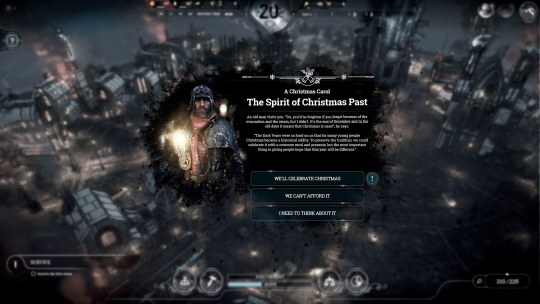
(Image from rockpapershotgun)
When I picked forceful persuasion, inmates were found dead as wardens had found the job of “breaking them” too pleasurable. The New Order welcomes a public execution space for anyone who is disobedient to me. I burned books. I-- a humanities student-- burned books for the sake of public morale.
Even saving refugees did not prepare me to accept the horrors I had committed as a leader. The game broke me.
This is what I would like to touch on-- Frostpunk, in my opinion, showcases the value as well as the problem with an authoritarian regime extremely well. You are given the avenues to make these hellish choices, as difficult as they may be, and are awakened to the horrors of the very real situations they mimic.
The political situation was akin to the Philippines’ Martial Law state... where those who spoke against the dictator were never to be seen again. This shows a very real political landscape where the decisions of the ruling government come to have an effect on the poorest of the poor and the youngest children. When because of your “forceful persuasion” law, children mimic it and bully younger kids on the street-- can you really feel so good about signing it into rule?
In the particular scenario I played through and along with the choices I made, we are given a taste of power through authoritarian rule, and we are also given a look into its consequence. I had a flourishing colony of survivors at the end of the storm, but I begin to ask the question so often asked in discussion of political theory and ethics: does the end justify the means?
This is, in its own way, showcasing the horrors of the Book of Law and the New Order and the demons unleashed by authoritarian rule.
I think though the scenario presented is undeniably fictional, the choices one is asked to make as well as the horrors in the arcs that follow as consequences of those actions stem from political and social realities. Dissenters leaving the colony; disobedient prisoners being inhumanely punished; history being rewritten to suit the ideals of a new regime. Such consequences and scenarios go beyond the virtuality of a video game and bring even the most raw of emotions to the forefront of the player.
Would I play it again? Yeah.
Will I ever be happy with the choices I made?
When I recognize these are potential realities that have happened or may happen, I don’t think I can ever be satisfied.

0 notes
Text
A Wig and a Bikini Isn’t Cosplay! aka Notes on How Women are Viewed in the Cosplay Community
disclaimer: this blog post is for an academic requirement, please do not attack me with pitchforks or fire
It’s evident to anyone who follows me on pretty much any social media platform, that I love to cosplay. My first cosplay was Mitsuha from Kimi no Na Wa, and I’ve recently upgraded from cloth-only cosplays to wearing armor made of EVA foam and styling my own wigs (which I’m not /great/ at, by the way.) I went from wearing a seifuku to having an armored corset and gauntlets, as well as carrying a sword during the entire convention! I love the cosplay community and all the creativity it inspires.
However, I also /hate/ all the controversy that comes out of it. Then again, hate is a strong word. A lot of the controversy in the cosplay community is often directed at issues of race and sexuality. For now, I will focus on the sexuality aspect, and the way women in the cosplay community are viewed for showing skin and being “sexy.”
“A Wig and a Bikini isn’t Cosplay!”
In recent years, “sexy” styled cosplay of characters, which usually involves lingerie or boudoir shots, as well as scantily clad outfits at conventions, has gotten some flack for not truly being “cosplay.” It has also gotten slammed because of the oversexualisation of characters, and for being generally not child-friendly. Women’s sexuality is cosplay is often discriminated against by cosplayers who prefer “accurate” cosplays, and yet is the preferred output of plenty of high profile cosplayers because admittedly, these sexualized versions of characters still sell.
Consider popular cosplayer Jessica Nigri.
This is one of her cosplays of Mitsuri Kanroji, the Love Hashira from Kimetsu no Yaiba.

This is what the character looks like in the show:

Some people might complain that in this shot, the only similarities between the character (accuracy points!) and Nigri’s interpretation are the sword/Nichirin blade, and the wig/contact lenses. This is what I mean when I say “sexy” cosplay. For others, this kind of material is great and is likely to sell.
It is no secret that photos of sexy versions of characters will likely sell more prints and get more attention than a full-armor cosplay that shows no skin, or a detailed sewing project that covers the whole body (even if it’s completely accurate.)
As Jessica Nigri is a well known cosplayer, she has been asked to cosplay at certain events-- but a revealing outfit has also gotten her in trouble, as management once asked her to change her outfit since it was deemed too sexy for the convention.
When we talk about sexy/boudoir/gravure/pin-up versions of characters as cosplay, we must consider the producers and consumers of this content. What are critiques on sexy cosplay?
This article from Vice has a couple of opinions from producers (and some statements from consumers/ others in the cosplay community).
For one Holly Wolf, a former playboy model turned cosplayer, she says there should be no difference between a regular cosplayer and a sexy cosplayer. Some characters are just designed sexier than others, and why should she get shamed for being attractive? People brand her as slutty or attention seeking, especially when she cosplayed a sexy version of Zelda from the Legend of Zelda series. Other women who do sexy versions of cosplay also get harassed to just get up and do porn.
Another camgirl turned cosplayer, Clara Cosmia claims there is more stigma in “being a hot girl,” because people assume that you don’t have to work as hard to be successful. Women complain that because their cosplay is “sexy” it isn’t considered serious, and is just for likes and views from (presumably) men. She also says that there is inherently pressure to do more sexy cosplay, because it gets more attention. Even if a cosplayer spends hours and days sewing a completely accurate outfit or building armor out of Worbla and EVA foam, the outfit that shows more skin will likely be more over-shared.
Karli Woods, who has been in the industry for a few years, has said that she wants people to know that you don’t have to do sexy stuff to be successful as a cosplayer.
Showing Skin In Context
Women are fetishized and seen as sexual objects in many ways-- to some degree, this sexualization of characters propagates the idea that women exist (or create sexy versions of characters) to appease the male gaze.
Economically-- this brings in the cash. A number of lewd cosplayers or boudoir/gravure cosplayers sell their digital photos and prints on Patreon, and can successfully make a living from this. It takes advantage of women’s sexuality and uses it to bring in cash for the content creator.
On the positive note, this can be taken as women being comfortable with their sexuality. They should not be discriminated against for wanting to wear more revealing cosplays, and if it makes them happy and comfortable, who are we to shame them for it? Does a cosplay have to be completely accurate in order to be considered a cosplay? Or, is the spirit of cosplay simply in portraying a character one likes for fun?
However, this also has implications on how we will view women as cosplayers, and what we expect from a popular cosplayer in the first place. Should success be dictated by how much skin you show?Is the pressure to do sexy cosplays too much for women who personally do not want to-- and does this hinder them from being successful in cosplay?
Not to mention body type: sometimes cosplaying outside of your body type is also discriminated against. I’ve personally been told that I can’t cosplay a character because I’m too chubby or short; and I’ve been told that I can’t cosplay a character just by virtue of me having too large a chest for them. Others will also be told that because they’re too ‘flat,’ they can’t cosplay a character that is inherently busty.
This video explains it pretty well.
youtube
Even in the cosplay community, where people are meant to have fun just portraying a character that they like, there is still so much discourse, controversy, and discrimination around women. You can’t cosplay out of your body type. Race is a whole other issue (white cosplayers cosplaying black characters and vice versa.) Sexy cosplays sell, but they’re too slutty. If you don’t show skin, then you won’t garner attention even for your skill and effort. Is it really fair that cosplay that is sexier garners more attention?
Personally, I think that the community still has a lot of issues to figure out-- and cosplay, even if it pertains to a character that exists only in fiction, still has implications in the real world. People’s comments about how cosplay should be are indicative of other real-world problems and issues within our society.
So, if you sell prints with just a wig and lingerie, are you still cosplaying?
I’ll end this with a video which I agree with entitled “The Real Problem with Sexy Cosplay.” The gist of it is that: sexy cosplay is great! It is, however, not for everyone, and we shouldn’t go around shaming people, or believing that it’s the only successful type of cosplay out there.
youtube
Sources
https://www.youtube.com/watch?v=lQNZKcyPcIU
https://www.vice.com/en_au/article/kz3zev/how-sexy-is-too-sexy-for-cosplay
https://kotaku.com/skimpy-outfit-gets-lollipop-chainsaw-cosplayer-asked-to-5900134
https://www.instagram.com/jessicanigri/
https://thetab.com/uk/bristol/2014/12/05/cosplay-costume-sexy-12628
https://www.youtube.com/watch?v=XmAC0cWihfs
word count: 1173
1 note
·
View note
Text
Digital Identity, aka “Hi, my name is Kai.”
disclaimer: this blog post is for an academic requirement, please do not attack me with pitchforks or fire
So, this time we’re going to talk about the digital identity that I’ve built online, and my digital footprint. Beware, we will be treading on some backstory here, but the outcome will more or less explain my usernames on most platforms.
Who is Kai?
For the longest time, since I was afraid of revealing my real name when playing games, I went by the usernames kairanshire (a reference to an old character of mine) and kyzarix (a bastardization of the words “Kaiser” and “Rex”); this led to me often being called Kai/Kairan or Ky in game. I eventually just adopted it, and I’ve been calling myself “Kai” in-game ever since.
Here’s a screenshot of my steam profile, where you can see that I introduce myself as Kai, as well as my Cosplay profile, which is called @kyzarixcosplay or Kyza Cosplay (Kaiza Cosplayer in Japanese).



Who is Sam?
On most other social media platforms that are not used for gaming, I use the handles kairanshire/kyzarix and yet still place my name as “Sam,” usually with some extra phrase to be quirky. I notice that my digital identity, or the way I present myself, also changes depending on the platform. Let us examine my facebook page, pictured below:
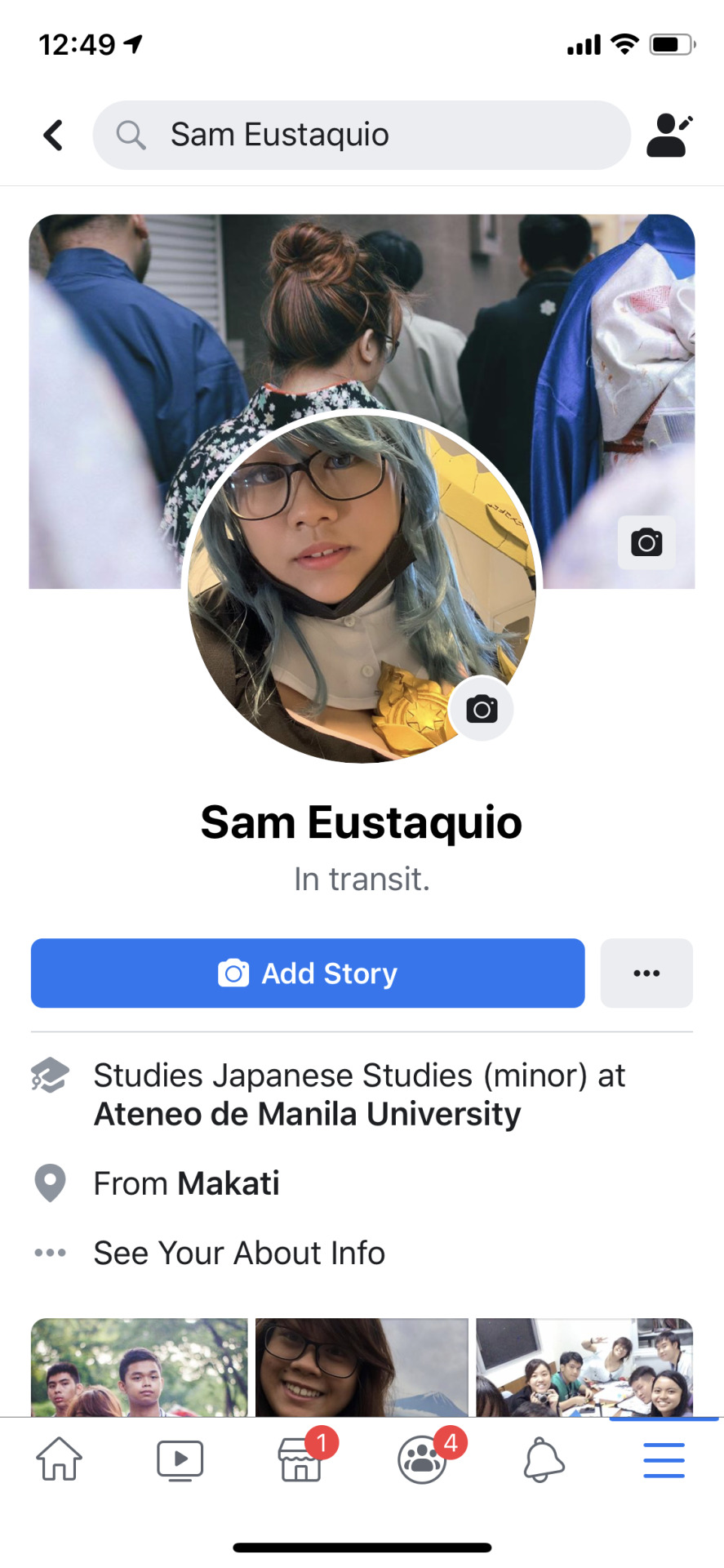

Majority of my posts on Facebook tend to be reposts, cat videos, and basic photos taken by friends and family. Compared to my other accounts, although majority of the people who see my Facebook are people I know in real life, I do not share much of my personal thoughts and feelings there. A typical Facebook post looks like this:
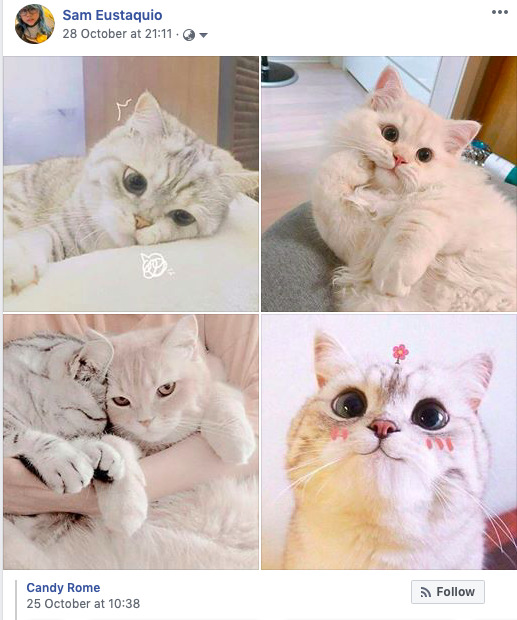
Which, for the most part tells those who see my posts that I generally like cats. I think majority of the posts on my Facebook page are cat related. Since I do not really want to reveal other parts of my identity on Facebook, I am content with being “the person who shares cat videos and photos” on someone else’s news feed. At least this way I don’t think I am offending people by posting pictures of cute animals.
On Twitter and Instagram, I tend to be more vocal and free with my posts. While I’m aware that these are shared to a more general public, I also for some reason, just feel better and don’t feel the need to curate my posts as harshly. I freely post ~aesthetic~ pictures alongside derpy cosplay pictures and retweets of anime screenshots. These accounts are pictured here:


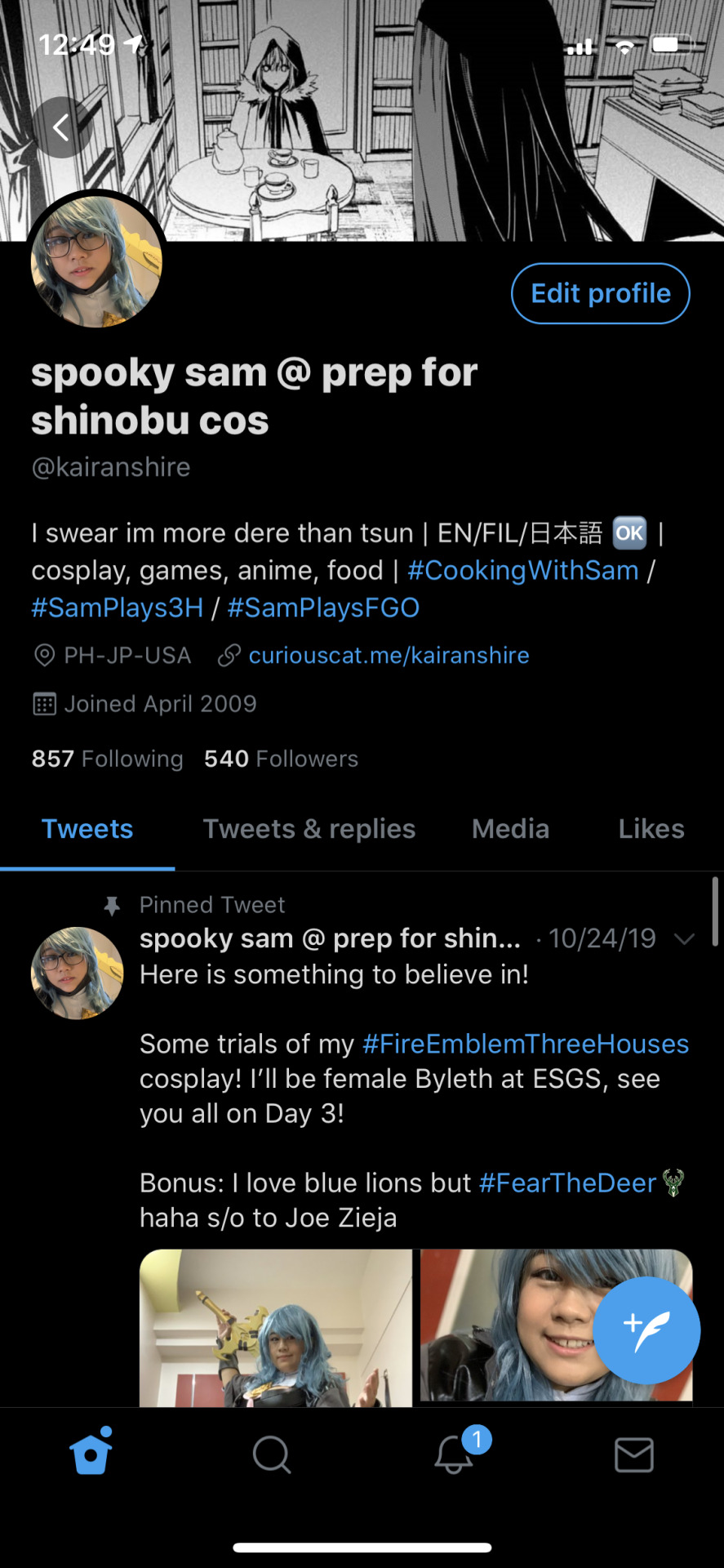

I also do not reveal my full name or any other personal information (workplace, school, major, age) on these accounts, which is probably why I feel more comfortable crafting an identity which caters more to my interests. This is how I have met a couple of my friends simply through our shared interests alone, rather than physical connections. Fellow weebs, cosplayers, dare I say the word “gamers” and makeup enthusiasts-- I don’t mind them seeing all my posts! That one person that added me just because I was beadle for a class? I do mind them seeing my cosplays because they might call me weeby, I mind them seeing what games I’m interested in because I fear they might judge me.
In addition, there is one last account that I will show here, which is my private Twitter account.
This one is not only locked, but also does not conform to my usual nomenclature (no kai here!). I definitely designate that this is a private/rant account, and this was actually made because my parents found my public twitter and called me out for not telling them when I got sick. I didn’t feel comfortable anymore with placing some of my rants (especially about sickness and more personal, sad issues) on my public twitter, since I felt that my parents reading it was an invasion of my privacy.
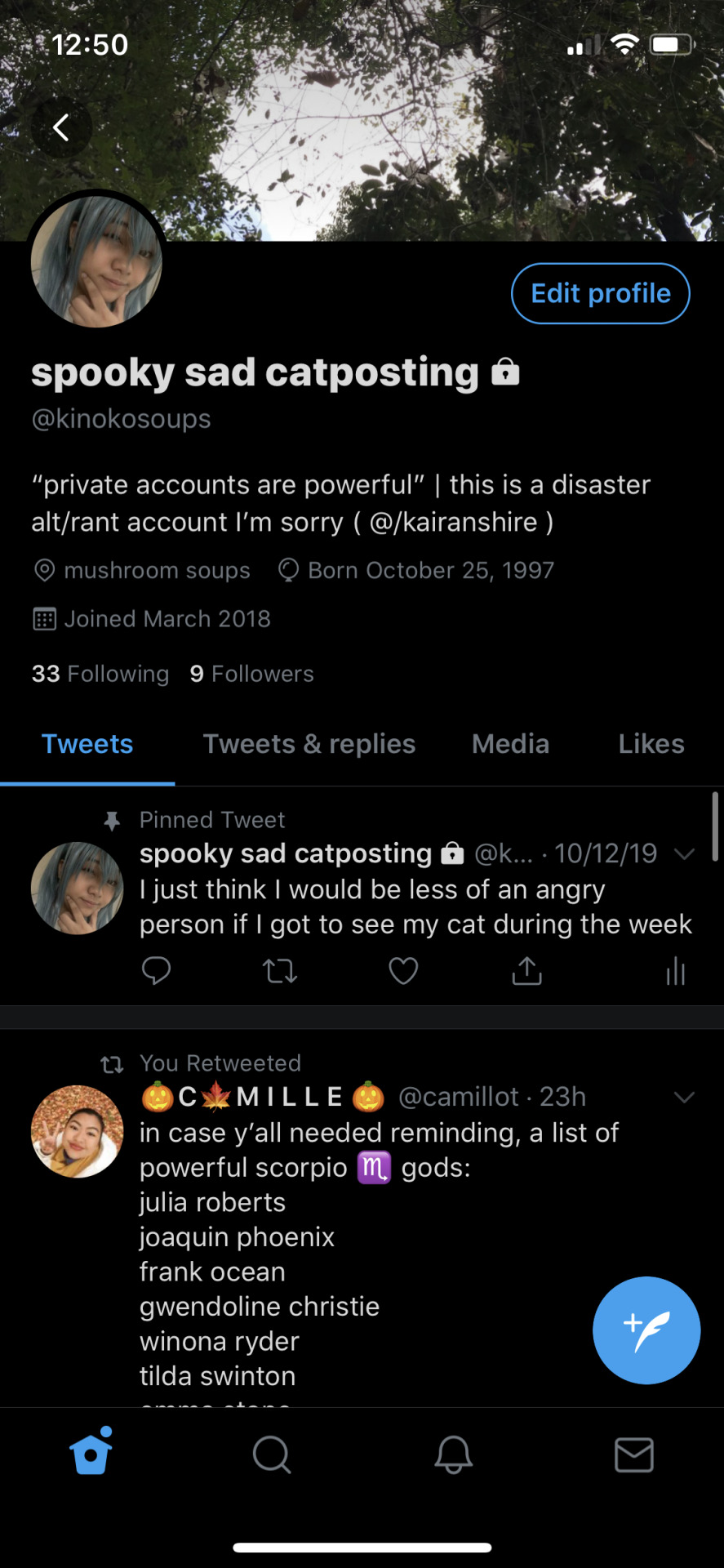

My posts are less retweets and more short rants, which I use as a diary of some type in order to vent. Every so often a friend whom I have permitted to see the content of this account will talk to me about what I’m feeling, which does comfort me to a certain degree. This is in essence a curated space for me to rant, where I can control who can and cannot see this part of me.
So, which one of these is the real you?
One question we need to answer is whether or not this digital identity is a faithful/truthful representation of how I see myself. To be honest, I would say that no matter which platform of social media that I am representing myself on, I am sharing a part of myself. These things are true, though they are incomplete (which I personally think, is okay.) There is nothing on these platforms that I personally am lying about. I do like cats, I love to cosplay, I love games, and I get angry and I rant sometimes. These may be spread out across multiple accounts, but I do not think of them as being necessarily untruthful for being incomplete. Even in certain friend groups our humor and personality and the things we talk about changes-- so why can that not apply to online accounts as well?
I don’t think the digital footprint I’ve left is a lie-- but rather that each account is a piece of a puzzle, which, even if you follow all my accounts, still are yet to be completed fully.
word count: 922
0 notes
Text
New Media, aka, “all my friends were made online”
disclaimer: this blog post is for an academic requirement, please do not attack me with pitchforks or fire
This time we were asked to make a blog post about New Media, more specifically, the culture that is presented with my own engagement with new media. So, here, I am talking about how a great majority of my friends were made with the aid of a computer screen, social media, and Minecraft.
But first, we must address the question:
What is New Media?
New Media is a general term for electronic communications usually facilitated through computer technology-- that is, everything that you experience because now we carry tiny computers in our pockets at all times. Examples of old media include print material like newspapers or books, or things such as television. Compare this to things like websites, podcasts, emails, and social media platforms. The way we experience things daily through computers and screens is a manifestation of *boom* New Media.
Okay, now what about the culture that is produced by this “new media?”
Here’s a fun fact! When I was around 12 or 13, I was a really lonely kid and I had very few friends in real life. I remember it was a summer when I convinced my dad that I wanted to get Minecraft (it was 2009 okay) to play online. I logged into a server and after maybe two days I had found a group of people who I ended up consistently talking to for the next 7 years of my life. These people were from all around the world: Australia, Hawaii, New Zealand, or the US.
I’m still friends with them. I still regularly talk to them-- three of us have birthdays remarkably close to one another (Britt and I share October 25, while Jye’s is October 26) so we used to video call one another and have a big online birthday party through Skype, which turned into Discord as we got older. We went from playing Minecraft together to playing Monster Hunter World, and even online games of D&D.
Have I met them in real life? No. Do I still consider them some of the best people I’ve ever met? Yes. Do I still consider them real friends? Absolutely.
New Media, especially Social Media, changes the way that friendships are made and kept. To this day people are investigating the effect social media has on friendship. Plenty of studies argue that Social Media tends to make us anti-social or cannot replace “irl” friendship (see the link above), and while I do agree to a certain extent, I do believe that there are aspects of New Media and Social Media that help us maintain old friendships and create new friendships.
Consider this video, that asks the question I’m asking here: Are internet friends real friends?
I’ve often been told that my “internet friends” aren’t my real friends, but how can that be when they provide support for me when I’m having troubles at home or at school? When I’m more than a thousand miles away from my boyfriend or my best friends at home, is staying connected through social media (since that is our only viable way of communication) somehow less genuine than sitting down over a cup of coffee?
Social Media is a venue of interaction and friendship, especially among the youth. It connects us to new friends, and helps us keep in touch with old ones, especially those where distance was not a choice between the two parties. (Let’s say, your best friend moved away and now you just FaceTime each other.) 64% of American teens say they have met new friends on social media, and 68% of American teens also say that they’ve received support from friends on social media.
We can’t deny that Social Media and the New Age of Communication (i.e. computers and discord) completely changes the way we interact; we become connected to screens and sometimes replace real life connections with ones that are entirely computer based. I’m not saying that stuff isn’t true, because it is-- Social Media does have some negative effects.
However, New Media also allows us to engage with friends all over the world, in new ways, and perhaps create “real” friendships online (whatever that means to these science people.) This way, online friends CAN be real friends.
In 2018, a group of gamers came together after years of playing games online-- all to visit one of their friends who had been diagnosed with Ewing’s Sarcoma. This just goes to show that you can make real friends online, it just matters how much time and effort you put into it-- just like real life. Leaving a like or a comment is certainly different than spending hours on a video call playing together like you would on a cough in your living room. When I myself was hospitalized, my best friends played MHW with me every day so I didn’t have to think about my chemotherapy. They weren’t allowed to touch me (not as if they could) because my body was literally toxic for days on end, but the laughs and the failures and the conversations were all very, very real.
youtube
Sources:
https://www.techopedia.com/definition/416/new-media
https://panion.com/blog/how-do-i-know-we-are-friends-friendship-age-social-media
https://www.pewinternet.org/2015/08/06/chapter-4-social-media-and-friendships/
https://www.youtube.com/watch?v=yzZE1oeqh7o
https://www.youtube.com/watch?v=JLIks3hL2o0
https://www.ladbible.com/news/news-online-gamers-meet-irl-after-one-fell-terminally-ill-20180929
0 notes
Text
3D Printing, aka “machines are going to steal your cheap labour”
thdisclaimer: this blog post is for an academic requirement, please do not attack me with pitchforks or fire.
What is 3D Printing?
3D Printing is the act of creating a 3D object, such as a figure, mechanical part, or physical model, through the use of a computer software (which contains the plans and components for said object) and a printer that prints in 3-dimensions (usually using materials like plastics or pvc.) First, you must make a model, or acquire a blueprint of what you would like to print. After you have a blueprint, you are able to print said material out of heated plastics through a 3D printer. If you’d like to go even deeper into the world of 3D printing, you can check out this video by Mashable:
youtube
Wait, but what does 3D printing mean for me? Or for other people who aren’t me?
Well, specifically for me, 3D printing means that I can get blueprints of D&D monsters, figures, and other printables, and print them out for my sessions. (You can do that here, by the way.) If I were to buy my own 3D printer.
“That would be expensive,” you might argue; thinking that only multimillionaires with factories can afford to buy such a thing. May I direct you to this list, where you can buy a 3D printer for around 170$? These are not simply factory machines, they could be there, in your own home, right next to your regular, 2D InkJet printer.
In fact, I could start my own 3D printing business if I wanted to. I could make 3D blueprints for figures or physical modifications to everyday objects. I could even 3D print others’ items for a certain price, which in the long run could possibly make a profit (depending on how expensive plastics are.) This can pave the way for different kinds of personal businesses. (By the way, you can learn how to make money through 3D printing here.)
But 3D printing also means that we change the way things are manufactured as a whole. Imagine, what used to take several workers doing tiny detail work on parts in order to get them to a very precise size and shape-- you instead just turn on a robot, upload a plan, and wait.
The 3D Printing agency says that minimum wage workers such as the ones in Cambodia could potentially lose jobs in clothing, textiles and footwear because of the rise of 3D printing and its accessibility for manufacturing. Automation is simply cheaper, and is less prone to human error. The Vice President of the Coalition of Cambodian Apparel Workers Democratic Union even says that without regulation by the government, the use of machine automation could create several social issues for low-skilled workers in the industry. They could, quite likely, be replaced by a hunk of metal that doesn’t need to eat.
So this is technically a bad thing, right?
Not entirely.
The innovation of 3D printing is a change in the very idea of creating something. President Obama even acknowledged it in his 2013 State of the Union Address, stating:
"A once-shuttered warehouse is now a state-of-the art lab where new workers are mastering the 3D printing that has the potential to revolutionize the way we make almost everything,"
This could potentially change the labour force forever. Countering the idea that machines might be stealing our jobs, it might also be creating new ones. There will be a demand for creatives and designers-- in creating blueprints and model designs, as well as integrating these parts into other parts.
This also has applications in the sciences, particularly in computer science, where knowledge of troubleshooting and software adjustment (particularly in Computer Aided Design or CAD) is extremely important for creating 3D printed parts suited to the user or buyer. (For example, for custom-created items.)
Greg Morris, the team leader for GE Aviation, claims that you wouldn’t be replacing machinists or other labourers, but that the job would be evolving: you would be asking them to learn a slightly different skill set. The rise of 3D printing would necessitate new workers trained to be technicians, designers, maintenance, and yes, quality control (even for robots!)
However... we can’t say that 3D printing is the most cost-effective solution at the moment. Even if the technology is becoming more and more accessible and cheaper, Timothy Laseter, a professor at the Darden school of business, says the production cost is still too high for it to replace the cheap labour of mass production.
Business Insider’s Rob Wile and 3DPrint.com’s Krasstein agree that it is too soon to say what 3D printing will do-- it may destroy thousands of jobs, but create a thousand more in the process.
We can continue to imagine and ponder the possibilities of 3D Printing in manufacturing, personal use, and the labour market, but in the end only time will be able to truly show us the impact of this innovation. New technologies continue to develop all around the world, and they do change society forever.
SOURCES:
https://dismalscience.journalism.cuny.edu/2019/03/28/worried-about-a-robot-taking-your-job-3d-printing-may-help-you-land-one/
https://www.businessinsider.com/how-3d-printing-will-affect-manufacturing-jobs-2014-8
https://3dprintingindustry.com/news/90-of-jobs-could-be-lost-85413/
https://www.youtube.com/watch?v=Vx0Z6LplaMU
https://www.3dnatives.com/en/low-cost-3d-printer290320174/
https://www.youtube.com/watch?v=imhAyR8OelA
https://geekandsundry.com/artist-releases-300-printable-dd-miniature-patterns-for-free/
1 note
·
View note